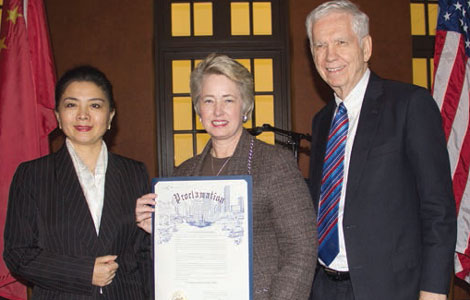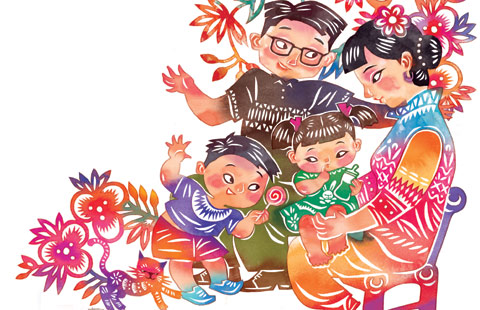Students support graphic tobacco warnings
Updated: 2014-03-04 09:33
By Wang Hongyi in Shanghai (China Daily)
|
||||||||
|
 |
| A child learns the benefits of not smoking at a cafeteria of the Medical School of Shanghai Jiao Tong University. In a survey, university students backed tobacco health warnings with pictures. [Provided to China Daily] |
Nearly 80 percent of university students in Shanghai support the use of shocking illustrations on cigarette packages to discourage people from taking up the habit, a new report said.
The survey, released by the Shanghai Health Promotion Committee on Monday, sought to find out how the city's university students view smoking control efforts. Nearly 2,000 students from the city's 21 universities participated, and 16 percent said they were smokers.
More than 70 percent of students said the warning labels on tobacco products sold on the Chinese mainland failed to make the public aware of the effect that smoking has on health. Forty-two percent said the warning labels don't specify the effects of smoking on health, and 32 percent said the labels don't have any effect at all.
Seventy-seven percent of students thought that illustrations of the diseases caused by smoking should be printed on tobacco packaging. And 85 percent believe that smokers would reduce or consider quitting smoking if more warning labels and pictures were included on the packaging.
Nearly 80 percent said it's never too late to quit smoking, and the earlier the better.
Warnings that use graphic images of the negative health effects of smoking are far more effective than text-only warnings, according to the World Health Organization Framework Convention on Tobacco Control guidelines. Tobacco product packaging is believed to be the most cost-effective communication medium available to governments to convey health messages. Many countries have already adopted illustration-based health warnings on cigarette packages.
Cui Xiaobo, a professor of social medicine at Capital Medical University, said China remains "conservative" with tobacco control and the use of gruesome illustrations on tobacco packaging.
"Health warnings with pictures are a very direct and effective way to reduce smoking. However, in China, the cigarette industry doesn't print pictures of gangrenous toes, rotting teeth, diseased lungs and hearts damaged by smoking on the packaging," Cui told China Daily.
"Chinese people like to give cigarettes as gifts. Luxurious and high-quality cigarettes usually account for the biggest chunk of the cigarette industry's profits. Once gruesome pictures are printed on cigarette packaging, those cigarettes won't be bought as gifts. That would have a great impact on the tobacco companies," Cui said.
China, the world's largest producer and consumer of cigarettes, has more than 300 million smokers. Smoking causes more than 1 million deaths a year in the country. Exposure to secondhand smoke also kills about 100,000 people in China every year, according to the WHO.
Since 2008, large cities such as Beijing, Shanghai and Guangzhou have enacted regulations prohibiting smoking in public places.
Under Shanghai's anti-smoking law, which took effect on March 1, 2010, 16 types of public venues such as hospitals, schools, bars and restaurants are required to establish designated non-smoking areas and post signs prohibiting smoking.
In recent years, the city has increased the supervision and enforcement of the law. In 2013, 252 venues and 107 people were fined 481,600 yuan ($78,353) for violations.
Smoking at Internet cafes and entertainment venues has decreased this year, but they remain the hardest places to implement the smoking ban in public places, said Li Zhongyang, director of the Shanghai health promotion committee.
"To improve enforcement, we will carry out broader publicity education activities of the negative effects of smoking, and we'll also encourage more volunteers to join in smoking control efforts," Li said at a news conference on Monday.
Contact the writer wanghongyi@chinadaily.com.cn

 China joins in NY Times' travel show
China joins in NY Times' travel show
 UN envoy condemns terrorism
UN envoy condemns terrorism
 Rio drops protests for Carnival
Rio drops protests for Carnival
 Houston-China bonds deepen with new group
Houston-China bonds deepen with new group
 Citizens mourn victims of Kunming terror attack
Citizens mourn victims of Kunming terror attack
 Putin justifies potential military move in Ukraine
Putin justifies potential military move in Ukraine
 Photos: Kunming rail station violence
Photos: Kunming rail station violence
 Successful businessman gives back to the community
Successful businessman gives back to the community
Most Viewed
Editor's Picks

|

|

|

|

|

|
Today's Top News
Terrorist group in Kunming attack busted
First Lady to visit China in March
2014 the year of the Chinese IPO?
China making progress on fighting pollution: experts
Michigan benefits from long-sighted ties building with Chinese
Detroit toasts all time high in China trade
China to severely punish terrorist attackers
Ukraine mobilizes after Putin's move
US Weekly

|

|






